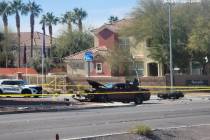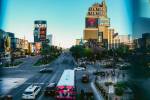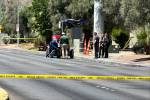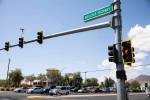It’s hard for drivers to see through bushes
How many times do you attempt pull out of a side street or driveway, but a business sign or overgrown shrub blocks your view of oncoming traffic. Sometimes the driver literally must hang back or pull the car into a lane of traffic to determine whether it is safe to make a turn. Daniel has a good point with his question today, and, because most of us can probably relate, we will start with him.
Unlike what seems to be the majority of the population that owns SUVs or trucks, I still own a car. I cannot understand why stores and businesses spend so much time and money to create landscaping right up to the curb. It makes it very difficult to see to my left before turning into traffic. I've noticed signs, shrubbery, trees, bushes, mailboxes, etc. blocking my line of sight. Can you please shed some light on this issue?
Most jurisdiction have setback policies, and those vary depending on factors like whether the road is curved and the speed limit. The visibility guidelines are in a manual called "A Policy on Geometric Design of Highways and Streets," published by the American Association of State Highway and Transportation Officials (AASHTO).
The city of Las Vegas receives this complaint frequently, and this is what spokeswoman Diana Paul had to say about the issue: Traffic engineers investigate complaints and notify the property owner if landscaping is overgrown or too close to the street or if a sign has been placed in motorists' line of sight.
Sometimes, the issue can be resolved by making some striping modifications on the street. Other times, the property owner must do some pruning or even remove signage.
If you have a complaint within the city, call 229-6615 or go to lasvegasnevada.gov and click on the quick link to the left labeled "request help with ..."
Warren asks: My question is on the safety of Highway 95 toward downtown. The surface is not flat; it has some elevation changes that make it seem like you're riding a roller coaster. The ups and downs last from Main Street Station to just past Las Vegas Boulevard. I'm guessing that because this is an elevated roadway, the spans between supports are sagging. Is this normal? Could they collapse? Will this be resurfaced?
It's important to first note that this bridge does not pose a danger. The structure of it is sound. That noticeable roller-coaster ride is because of the camber built into the road, according to the Nevada Department of Transportation. A camber is any curve on the surface. The camber is designed to allow each span of the bridge to support both dead weight -- the weight of the actual structure -- and live load -- the traffic. An upward camber is typically built in so that it will push down to a flat condition with a live load. In some cases, an insufficient camber is built in, and the sag in the span becomes noticeable. Resurfacing over the years exacerbates the roller-coaster feel to the road. The danger that this poses over the years is related to drainage and water pooling on the roadway, but NDOT engineers say they have addressed that on U.S. 95.
Jim is tired of dodging panhandlers: We've had so many pedestrians hit by vehicles, it makes you wonder why police don't crack down on panhandlers who weave through cars and sometimes don't bother getting out of the street when traffic starts to move again. We have enough problems with people and cars, why are these panhandlers allowed to get away with this?
Good question, Jim. This is a tough situation for officers because these are residents who are already struggling financially. According to Las Vegas police, loitering in traffic lanes is illegal, and panhandlers can be cited for soliciting on a roadway, interfering with traffic or walking in a road where a sidewalk is provided.
Unless police receive a number of complaints about a particular panhandler or the panhandler is harassing motorists, they rarely issue a citation. One reason is because, as I mentioned, the panhandlers are already struggling, and issuing a citation will not help matters, not to mention that it is unlikely the ticket would be paid. When citations are not paid, arrest warrants are issued. If the person winds up in jail, then it is you and I who are held responsible for paying for their food and medical care while they are in jail.
A caller wants more surfacing like I-15: Is the Nevada Department of Transportation going to start using rubberized asphalt on all resurfacing projects? The material is not only environmentally friendly, but it is also quieter and smoother. What makes the department decide when and where it will be used?
For those who might be unaware, the recycled tire mix was used on Interstate 15 between the Spaghetti Bowl and Tropicana Avenue recently. It had previously been used on a portion of U.S. 95 in Henderson. The material is more expensive than traditional asphalt, but the upside is that is more durable and lasts longer.
The department is reserving the material for roads heavily traveled, mainly freeways. It is too expensive to resurface roads that are traveled less frequently because the asphalt typically lasts far longer than it would on a busy road like a freeway.
If you have a question, tip or tirade, call Adrienne Packer at 702-387-2904, or send an email to roadwarrior@reviewjournal.com. Include your phone number.
• Through Monday , expect lane restrictions on U.S. Highway 93 between Boulder City and the Hoover Dam bypass bridge as the highway is widened. Construction will be ongoing during weekdays and weekends.
• Through Dec. 9, travel lanes on Fox Lake Avenue and Cascade River Street will be restricted while a sewer line is installed.
• For two months, expect lane restrictions on Torrey Pines Drive for resurfacing between U.S. Highway 95 and Cheyenne Avenue.
• For the next eight months, expect delays on Jones Boulevard between U.S. 95 and Sahara Avenue as the road is widened.
• For four weeks, lane restrictions will be in effect 24 hours a day on Rainbow Boulevard. It will be reduced to one lane between Gowan Road and Red Coach Avenue while crews repave the street. Alternate routes include Tenaya Way and Rancho Drive.
• For the next month, expect delays on Hualapai Way between Charleston Boulevard and Town Center Drive and between Anasazi Drive and Town Center because of a landscaping project.
GASOLINE PRICES
The average price of gasoline in the Las Vegas Valley on Tuesday was $3.54 per gallon; the current state average is $3.56; the national average is $3.41. Find the Las Vegas Valley's best deals at gasbuddy.com.























